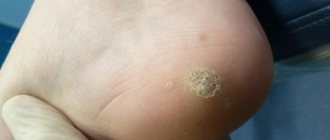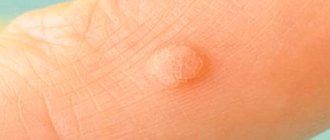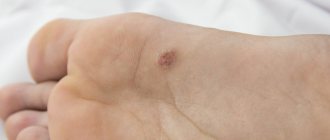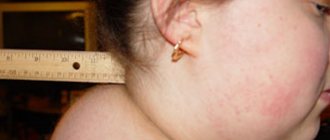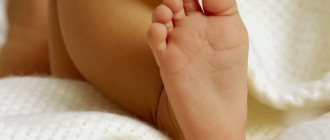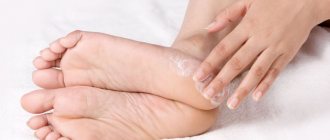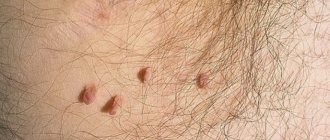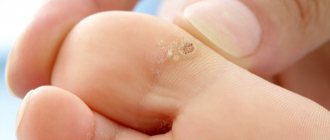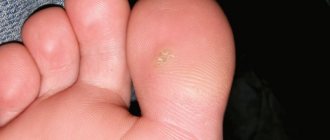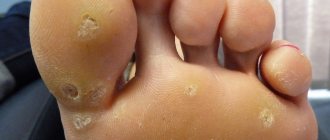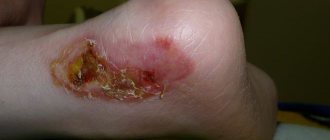A wart or papilloma is a growth on the skin caused by the human papillomavirus (HPV). The formation is benign and does not pose a health hazard. If a large growth is located on the foot or toes, it causes pain and discomfort when moving. To avoid this, it is recommended to get rid of the wart on your toe.
basic information
Viral warts are benign in nature. Their appearance means the progression of one of the types of human papillomavirus against the background of decreased immunity. It is completely impossible to cure such a disease.
Reasons for appearance
The appearance of growths on the feet has several reasons, the main of which is considered to be the presence of microtraumas and cracks in the skin. The virus easily penetrates the injury and activates blood flow to the wound. As a result, a wart appears in this place.
Visiting crowded places and communicating with people who are carriers of such an infection creates a risk of infection, since the virus is transmitted through contact. The virus may not appear for a long time. The reasons for its activation are considered:
- tendency to sweat;
- weak immunity;
- constant stressful situations;
- multiple injuries of the upper and lower extremities;
- avitaminosis;
- hormonal imbalances;
- unbalanced diet.
Infection most often occurs in places characterized by high humidity, for example, in a bathhouse, swimming pool, gym or sauna.
Types of neoplasms
Warts come in different types. They differ in appearance, structure and shape. The most common are warts vulgaris, which usually appear in childhood and can last a lifetime. There are cases when such neoplasms disappear on their own, without any medical intervention. The characteristic features of vulgar warts are:
- dome-shaped;
- dense structure;
- gray or pink tint;
- black dots inside.
Such neoplasms usually do not cause any particular discomfort. But if the wart is located on the foot or between the toes, in the form of a growth, then pain and discomfort are possible while walking.
There are several other types of viral tumors:
- Flat. Such compactions without a clear boundary occur in many people. They are usually located on the feet, body or arms.
- Age-related. They appear as brown spots in older people and are divided into flat, pointed and dome-shaped.
- Teenage. Such warts appear in the form of growths in children. They do not require any special therapy.
- Periunguals. They are often confused with fungus. They look like flaky skin and can be painful.
Correct diagnosis will help you deal with the problem faster.
Characteristic symptoms
New growths on the skin are not always viral in nature. Characteristic signs of viral warts are:
- nodular structure;
- dense surface;
- rough growth on the nail plate;
- cauliflower-like growths;
- oval or circle shape;
- dark or light halo along the contour;
- blockage of blood vessels in the form of black dots.
How to determine the disease
Many skin pathologies are similar, and a wart is no exception. For example, it can sometimes be confused with an old callus, so it is important to know what the growth looks like. The most important sign is the appearance of a brown, pink or yellow lump near the big toe, on the little toe and sole. Sometimes skin damage occurs between the toes, which also causes inconvenience when wearing tight shoes. Places near the affected area become more sensitive and sometimes hurt.
The wart can be flat or round, peel and flake a little. The edges of the formation are always clear, the size most often does not reach more than 1 cm. Small burgundy or black specks on the tumor are often noticeable - these are damaged blood vessels.
Treatment methods
If a wart on your toe is diagnosed, you can get rid of it using medications, folk remedies, or surgery. Each of these methods has its own advantages and disadvantages. All drugs that can be purchased at the pharmacy are divided into:
- Caustic solutions based on alkalis and acids. Such products are very effective, but they literally burn out growths on the skin. Their use requires caution. To remove warts, you can use Solcoderm, Feresol, SuperClandestine or Verrucatsid.
- Sprays with a freezing effect. To remove tumors, cryopreparations such as Wartner, MaxiVart or CryoPharma have been developed. Using a can of refrigerant, you can freeze a wart in 2-3 procedures. Low temperature will quickly destroy the pathological growth, and after a few minutes it will peel off from the epidermis. But large and old spines cannot be removed immediately.
- Medicines for external use. This is a slow way of dealing with thorns, but the most gentle of all. Gels and ointments do not cause side effects. The most effective remedies include drugs such as Vishnevsky's liniment, Oxolinic ointment, Imiquimod cream, Salicylic paste, Viferon gel, Panavir gel.
- Salicylic patch. Mediplast, Salipod, Ultra Profi H Dr are used to destroy viral tumors. House. The basis of all patches is salicylic acid, and the difference between the drugs lies only in the concentration of the main substance. If the tumor is located on the sole, then the patch will not be suitable, as it will constantly slide off. It is recommended for use on warts on the little toe or between the toes.
You can also remove growths using laser therapy or electrical destruction in a cosmetology office. The advantage of the first method is the absence of relapses and a very affordable price. Laser removal of tumors is a painless procedure. The second method is to use electrical impulses, which, penetrating inside the growth, destroy its structure and separate it from the surface of the skin. But after such a procedure, scars and scars often remain.
Using similar methods, you can remove not only external growths, but also remove old internal growths between the fingers.
Mechanical removal
Medicine and cosmetology offer several effective options for removing growths on different parts of the body. For a wart on the leg, it is recommended to choose the following methods:
- Cryodestruction. Wart removal occurs by exposing the affected skin to liquid nitrogen (temperature slightly less than minus 200 degrees). It is better to choose this method if the growth appeared less than 6 months ago - this way the result will be maximum. There are 2 types of nitrogen therapy: aggressive and conventional. In the first form, nitrogen is applied until a light spot with a diameter of 2–3 mm appears around the new growth. In the second type, nitrogen continues to be applied for 5–20 seconds after the light spot appears. It is more reliable, but causes severe pain during the session. After the procedure, the skin becomes very red and swollen, then a bubble filled with liquid appears at the site of the wart. Within a week, the wound dries up and disappears, and new healthy skin appears.
- Laser therapy. Another effective method, but less painful. Using a laser beam, the wart is burned out layer by layer, and the specialist regulates the depth and power of the impact. Bleeding does not occur, since the laser simultaneously with cauterization of the growth solders the damaged vessels. The procedure is safe and can be used even when treating children. After a session to get rid of the defect, a thin crust appears. It disappears on its own after a few days; there is no need to treat the dermis.
- Electrocoagulation. The chicken wart near the finger is exposed to electric current. There is no need to be afraid of the procedure; it is performed under local anesthesia. Blood loss also does not occur; current pulses quickly seal the vessels. The growth noticeably dries out and decreases, then disappears within a week.
- Radio waves. Most often, patients resort to this method when the wart is large. The seal is affected by a special apparatus that heats the tissue, causing the infected cells to evaporate. The growth disappears almost immediately, leaving a crust in its place. There is no pain or bleeding observed during the session.
- Surgical excision. The method has been tested for years, but is now falling into second place. It is more painful and traumatic, the rehabilitation period is up to one month. Warts on the leg are cut off with a scalpel or scissors under local anesthesia, and stitches are applied after the operation. They are removed after a week, then the skin should be treated with an antiseptic.
Removing warts with liquid nitrogen
Folk remedies
There are many folk recipes that are very effective in the fight against warts. But in any case, before using them, you need to consult a doctor. The best traditional methods are:
- Garlic. Garlic pulp, juice or a clove cut in half are suitable for treating skin tumors. The product must be applied or dripped onto the problem area.
- Vinegar essence. This method can easily get rid of a wart on the little toe. For half a dessert spoon of the product you will need one clove of garlic, crushed to a pulp. The mass should be applied to the neoplasm and secured with a band-aid. The bandage cannot be removed during the day. After removing the product, the skin must be wiped with vegetable oil.
- Watercress. From this plant you need to prepare an ointment, for which you will need 2 tablespoons of juice and 50 g of butter. Beat the mixture well and spread it on the wart on your big toe.
- Celandine. Using the juice of this plant is very effective in combating any neoplasms on the skin. The main thing is not to overdo it so as not to get burned.
When removing a wart yourself at home, you should be careful not to damage the adjacent skin. It is recommended to make a hole in the adhesive plaster, leaving only the wart open for treatment.
Possible complications
If measures are not taken to treat the tumors, the warts grow and the skin takes on an unhealthy appearance, its structure becomes heterogeneous. As a result, complications may arise:
- spread of warts to all parts of the body;
- degeneration into a malignant tumor;
- traumatization of growths and secondary infection.
Any type of neoplasm requires close attention. It is important to promptly treat warts on the toes.
Danger in children
Need advice from an experienced doctor?
Get a doctor's consultation online. Ask your question right now.
Ask a free question
In children, growths on the legs and fingers occur due to an insufficiently developed immune system that cannot resist HPV. If the child has no problems with general immunity, then local immunity is less developed. The main causes of warts are: non-compliance with personal hygiene rules in children's groups, the use of other people's toys, and the habit of biting nails. When treating, the age of the child should be taken into account. Cauterizing medications are not recommended for children; they are treated with salicylic acid-based ointments.
A course of drug therapy is prescribed from the age of 4 years.
Preventive measures
In order to avoid the appearance of a viral wart on the toe, it is necessary to take a number of preventive measures:
- Other people's towels are taboo; you should only use your own personal hygiene products.
- It is necessary to try on shoes in a store on the sock, and not on the bare foot.
- Avoid walking barefoot in public places such as a swimming pool or sauna.
- You can't wear someone else's shoes.
- You should combat excessive sweating of the feet.
- You should always sanitize cracks and wounds.
- You should purchase only high-quality shoes of the appropriate size.
Following these simple recommendations will help you avoid the appearance of warts on your feet and between your toes. In addition, it is necessary to strengthen the immune system so that the body can cope with the virus, even if infection occurs.
